MXA’S 2013 KTM 250SXF MOTOCROSS TEST: THE MOST POWERFUL PRODUCTION 250 FOUR-STROKE EVER
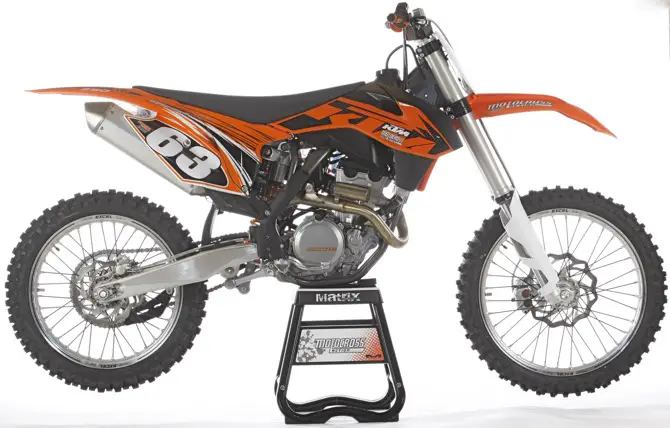
Q: FIRST AND FOREMOST, IS THE 2013 KTM 250SXF BETTER THAN THE 2012 KTM 250SXF?
A: It would be hard-pressed not to be, because the 2012 KTM 250SXF was the slowest and heaviest 250 four-stroke made in 2012.
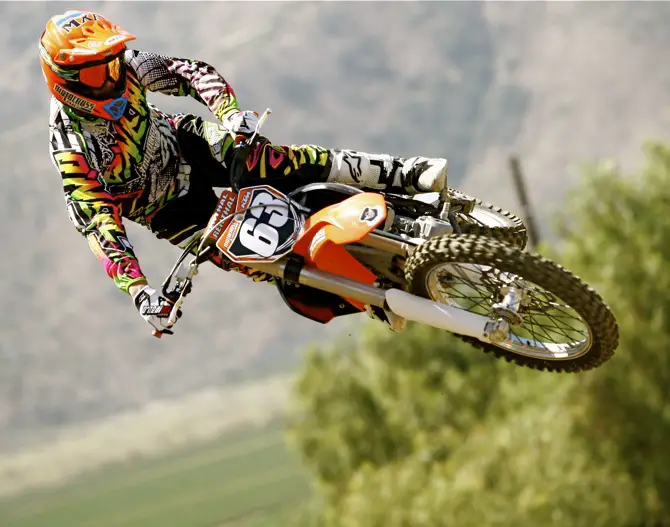
Q: WHAT HAPPENED BETWEEN THE 2012 AND 2013 MODELS?
A: The MXA wrecking crew admires KTM’s technical staff for holding their tongues during the berating they took over the doggy 2012 KTM 250SXF. At the time, we thought that they were suffering in silence, but now that we’ve seen the changes they made to the 2013 250SXF we realize that they were just biding their time. So, what’s new for 2013? Everything of importance.
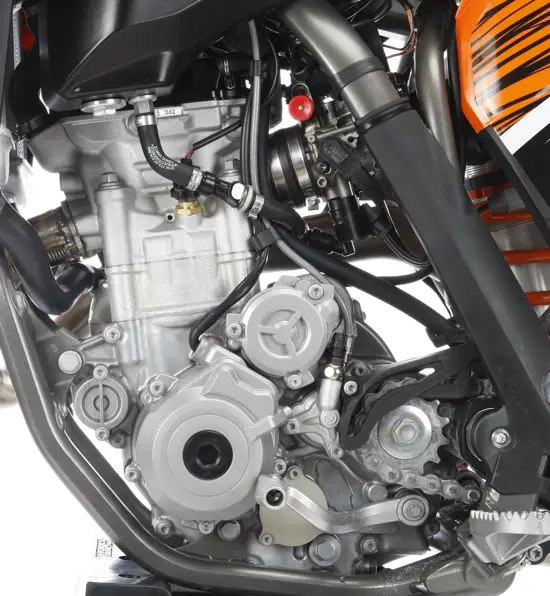
Q: WHAT CHANGES WERE MADE TO THE 2013 KTM 250SXF?
A: Before we break down the individual pieces, a grand overview will help make sense of the changes. For 2013 the 250SXF gets a totally new engine, redesigned frame, stronger swingarm, new triple clamps, U.S. spec suspension, 25mm rear axle, 12mm taller handlebars, black anodized spokes, bigger airbox, upgraded bodywork, thread-on gas cap, multiple micro-screen fuel filters, beefier radiators and larger 44mm throttle body.
Q: WHAT’S NEW ON THE 2013 KTM 250SXF ENGINE?
A: First and foremost, KTM threw the old 250SXF into a dumpster on the outskirts of Vienna. Good riddance, because last year’s 250cc four-stroke engine produced four horsepower less than its class leading green competitor…and shockingly, less than its previous orange brethren. Here is a list of KTM engine upgrades:
(1) Bore and stroke. Left behind is KTM’s old 76mm by 54.8mm bore and stroke engine configuration. The 2013 model gets a 2mm larger bore and a 2.5mm shorter stroke. You don’t need a degree in mechanical engineering to see the rpm possibilities of this short stroke design.
(2) Cases. KTM had built a solid reputation on its sand cast engine technology. It allowed for quick modifications and low-cost development, but it carried with it the burden of extra weight and porous wax-cast aluminum. No more! For 2013 the 250SXF gets high-pressure, die-cast engine cases?resulting in thinner walls, improved metal structure and higher strength. In addition, the 2013 cases have been streamlined by the removal of the kick start castings and by borrowing the water pump, counterbalancer and timing chain gearshaft from the Ryan Dungey Replica. This allows one shaft to do the job of three shafts.
(3) Cylinder head. Using the 350SXF as a base for the new 250SXF engine, the 2013 cylinder head gets larger intake valves (30.9mm to 32.5mm) for a 14% increase in valve area (made possible by the new 78mm bore). The Konig bridge-box piston is designed to produce less vibration at high rpm?important on the 2013 engine.
(4) Crankshaft. With the rev limiter set at 14,000 rpm, a stock crankshaft has never faced the challenge that the 250SXF’s big-end will in 2013. To ensure that it is up to the task, KTM commissioned Formula 1 supplier Pankl to build them a special lightweight connecting rod, and, as icing on the cake, they swapped out the old big-end bearing for a plain bearing (bushing) that doubles the maintenance interval.

(5) Exhaust. The big news about the KTM 250SXF exhaust system is that it can be removed from the bike without having to take the shock off the bike (it pulls out the front now). The head pipe is hydroformed (with water pressure) into a tapered shape. KTM has added a resonance chamber to go along with a tapered muffler core and sound reducing wire screen in the end cap. The sound screen looks like a spark arrestor, but doesn’t pass the USFS test. Given that we sound tested the 2013 KTM 250SXF at 112.8 dB (3 decibels below the two-meter-max requirement), we removed the screen door-style screen to avoid having it clog up with muffler packing particles later.
(6) Transmission. The 2013 KTM 250SXF gets a totally new six-speed gearbox, but the only gear that has a different ratio is second gear?which is taller and closer to third gear. However, the final drive is also lower at 13/50. It was 13/49 in 2012.
Q: WHAT’S UP WITH EMS, TPS AND EFI?
A: KTM calls their EFI system EMS?for Engine Management System (every manufacturer has their own acronym for EFI). For 2013 KTM reconfigured their complete EFI system with a 2mm larger throttle body venturi (44mm from 42mm). Uniquely, KTM moved the location of the spray nozzle from the top of the venturi to the bottom so that it sprays upwards into the air stream. KTM claims that this atomizes the fuel more thoroughly because the fuel velocity is greater at the bottom of the throttle body orifice than at the top.
It’s no secret that KTM had serious Throttle Position Sensor (TPS) issues in 2011?even though they used the same TPS as Kawasaki and Suzuki. The problem was water contamination. In 2012, KTM added a rubber cover and marine-grade wiring harness. It helped. For 2013, they replaced the plastic cover with a more secure plastic guard and upgraded the wiring harness with a longer lead and rubber caps.
In a nice touch, KTM has quick-release fuel lines with an in-line fuel screen built into the connectors to keep grit out of the 14-hole nozzle. On a side note, the previous choke/idle knob is now a hot/cold start button, while the idle adjuster has been moved to the back of the throttle body.
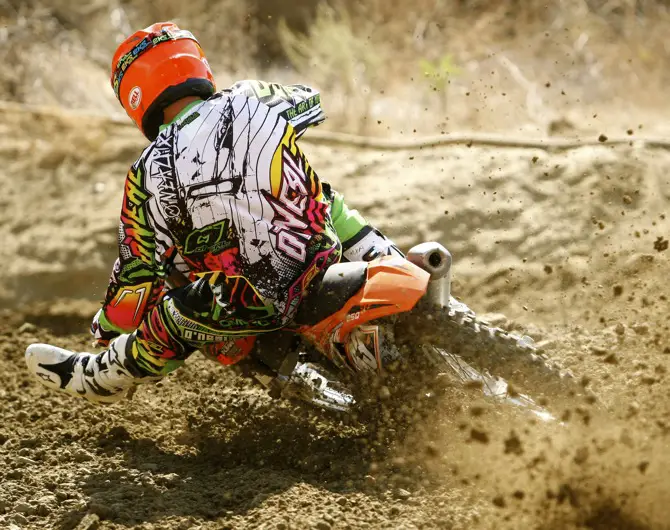
Q: HOW DOES THE 2013 250SXF COMPARE TO LAST YEAR’S MODEL ON THE DYNO?
A: Either KTM is doing something right in 2013 or they were doing something horribly wrong in 2012. Compared to the 2013 KTM 250SXF the 2012 model was a real dog. How bad was it? KTM’s 2013 brochure guarantees “a significant power increase of 5 plus horsepower.” That is either a bold statement of their current engineering competence or a condemnation of their previous engine incompetence. In truth, it is both.
True to their word, the 2013 KTM 250SXF does make 5 horsepower more than the 2012 model. Actually, because it revs to 14,000 rpm there are spots on the high-end of the dyno curve where the 2013 KTM 250SXF is making 7 more horsepower than the 2012 model (which peaked at 10,800 rpm).
Q: HOW MUCH HORSEPOWER DOES THE 2013 KTM 250SXF MAKE?
A: Hold on to your hat! It breaks the previous unimaginable 40 horsepower barrier. In fact, it pumped out 42.89 horsepower. Say what? It makes a little less bottom than last year’s KTM, but we are talking about power below 7000 rpm. After 7000 rpm it matches the low-to-mid transition of the 2012 and then kicks into turbo boost at 8100 rpm. It doesn’t stop pulling until it makes peak horsepower at 13,500 rpm. It cracks 40 ponies at 11,000 and stays above it all the way to 14,000 rpm. The torque curve mimics the horsepower curve?with less torque below 7000 rpm and more torque above 8100 rpm.
Not all is peachy with the massive amount of horsepower. why not? The peak power is way up there and the power delivery is very linear?which means that it takes a long time to get to the top, if you start at the bottom. Thus only riders who can jam in a new gear with striking regularity and take advantage of the thigh rpm powerband. It’s not our cup of tea?we want more mid and would give up some top to get it.
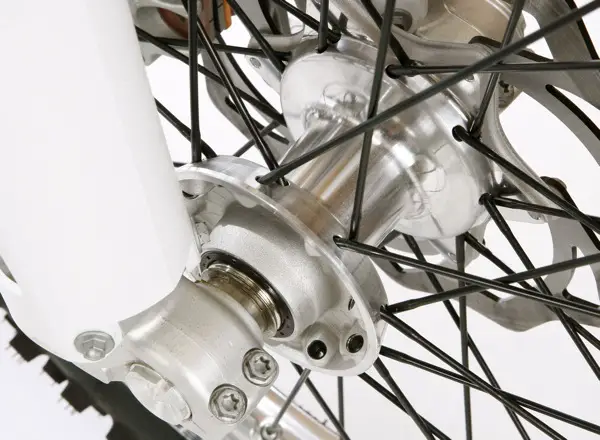
Q: WHAT DO WE THINK ABOUT THE ELECTRIC STARTER?
A: It’s a catch-22. We’re torn between the convenience of starting the bike with a press of a button, and the added bulk. When confronted with this same question last year, the MXA wrecking crew were split down the middle. However, due to a stronger powerband and revised suspension, the extra poundage didn’t seem to spark as much criticism this year.
The debate about the electric starter was squashed the minute that testers realized how fast the engine was. Weight in motion feels much better than riding a hefty bike that’s also slow. However, the 231-pound weight is noticeable when taking the 250SXF off a stand and in low-speed corners. Having said that, we prefer the ease of the electric starter. On a side note, we managed to unplug the fuel pump, located above the airbox, while reinstalling the seat. Beware.
Q: DOES THE 2012 KTM 250SXF PASS THE AMA/FIM SOUND TEST?
A: Does it ever! The 2013 KTM 250SXF rings in at a pleasant 112.8 decibels in the 115 dB two-meter-max test. While many of the other manufacturers are showing up late to the sound party, KTM is at the forefront.

Q: HOW DOES THE 2013 KTM 250SXF HANDLE?
A: The 2013 KTM 250SXF is an excellent handling machine. It doesn’t suffer the dreaded front-end wiggle at turn-in, maintains stability at high speed, and doesn’t do anything strange. Every MXA test rider raved about how balanced the chassis felt. We think it has everything to do with the steel chromoly frame. KTM has managed to fine tune the chassis to the point of perfection, although it is still up to the rider to find the perfect balance between the front and rear. While the 250SXF might not cut a line as tight as the Suzuki RM-Z250 or Honda CRF250, it is also doesn’t have headshake issues. It is effortless to ride.
“Point and go” is the best way to describe how the 2013 KTM 250SXF handles. What does that mean? Successful corner navigation requires nothing more than minimal handlebar input. Point the 250SXF where you want to go and be amazed as the bike tracks in the desired direction. Flat, hardpack corners aren’t an issue, nor are sweeping fast turns. The 2013 KTM 250SXF corners as accurately as a sniper.
Q: WHAT DID WE DO TO MAKE THE KTM 250SXF WORK BETTER?
A: We found happiness in the 2012 KTM 250SXF after making these four changes:
(1) Map switch. Just like every EFI-equipped bike, the 250SXF ignition can be tweaked. We installed an ignition map switch ($61.99, KTM Powerparts #77239974000). There are two preprogrammed settings: position 1 is softer, with the ignition retarded one degree less than stock; position 2 is more aggressive, which is advanced by one degree from stock. Every MXA test rider preferred the aggressive map. It improved throttle response and hit.
(2) Lower the oil height. We should automatically assume that every time we test the 250SXF we’re going to bleed 10cc of excess oil out of the forks. Don’t KTM’s test riders feel the same midstroke harshness that MXA testers deal with every year? Maybe they ride on paved tracks.
(3) Invest in a tooth. Although the 2013 KTM 250SXF engine can reach nearly 43 horsepower, it’s all for naught if you can’t use the powerband. Snd the amount of horsepowe is ruined by the lacksadaiscal manner in which the 250XF delivers it. By adding a tooth to the rear sprocket we were able to close the gap between gears. Those riding very tight tracks might want to go up two teeth (13/52) from stock.
(4) Add a pipe. It’s not that the 250SXF needs more power. Instead that power needs to be redistribute lower in the powerband.
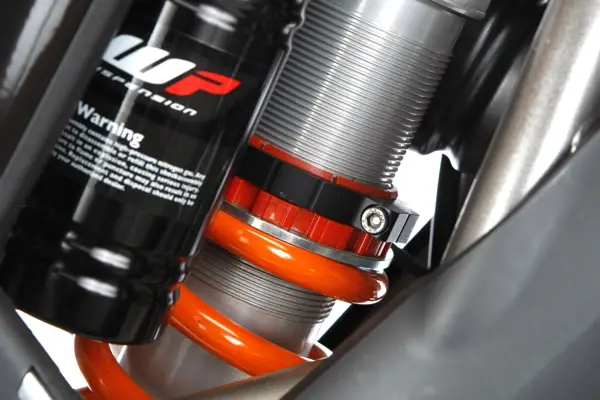
Q: WHAT DID WE HATE?
A: The hate list:
(1) Weight. Taking the 2013 KTM 250SXF off a bike stand is like dead lifting a beached whale. At 231 pounds, this bike is robust. Worse yet, it feels heavy in low-speed corners. The only saving grace is the electric start, but is it five extra pounds too high a price to pay?
(2) Grips. The 250SXF no longer comes with Renthal dual-compound grips, but instead medium compound Domino grips. Bummer, but adequate.
(3) Shock preload ring. After a few sag adjustments the plastic preload ring looked like it had fallen into a wood chipper. It’s impractical to use plastic on such a part. Speaking of impractical…
(4) Gearing. Even with the closed gap between second- and third-gear in the new transmission, as well as the 13/50 combo, the stock gearing is Bonneville Salt Flats tall. Add one tooth and think about adding two (if you want to maximize engine output).
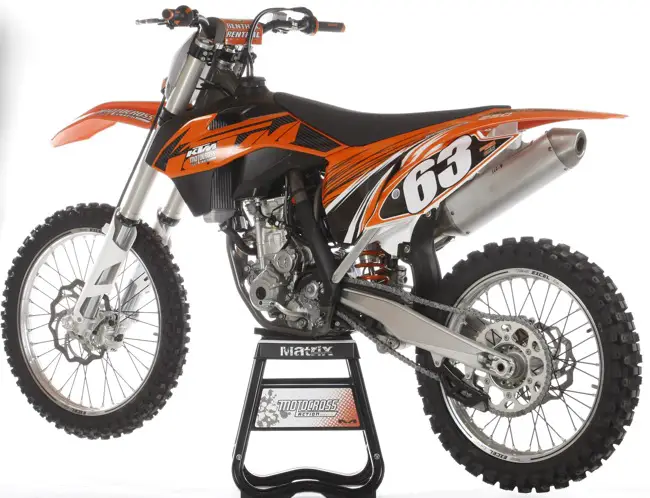
Q: WHAT DID WE LIKE?
A: The like list:
(1) Handling. The 250SXF will hit any corner on a track. The bike sticks like glue, even on hardpack flat turns. It’s confidence inspiring.
(2) Engine. Last year’s powerplant was a disappointment. However, KTM is returning to their horsepower roots by pumping a mind-blowing 42.89 ponies out of the 250SXF. That’s unbelievable! It’s a powerband designed for faster riders (and fast riders only), but with a few changes (ignition mapping, gearing and exhaust) it will cater to a broad range of skill levels.
(3) Ergonomics. The 250SXF has a huge contact patch. The bike feels slender, and the narrow shrouds and side panels make it easy for riders to squeeze with their knees.
(4) Clutch. What’s not to love about a hydraulic clutch?
(5) Brakes. KTM’s brake setup is than what pro riders relied on five years ago. The brakes are incredible!
(6) Gas cap. KTM finally gave up on their one-click gas cap and returned to a more traditional design. Thank heavens.
(7) Sound. This bike purrs like a kitten at idle and won’t bust eardrums at full tilt. Bravo!
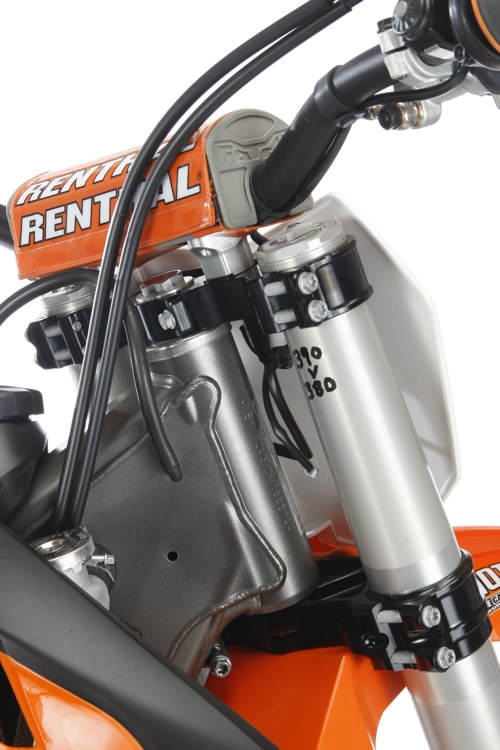
Q: WHAT DO WE REALLY THINK?
A: What a difference a year makes! The 2012 KTM 250SXF was the ugly duckling of the class. With a weak engine and suspect suspension, the bike was bad. No more! KTM went back to the drawing board and created an engine that breaks the 40-horsepower barrier. That, along with a host of other revisions, turns the KTM 250SXF from the dog of 2012 into a Champion pedigree in 2013.
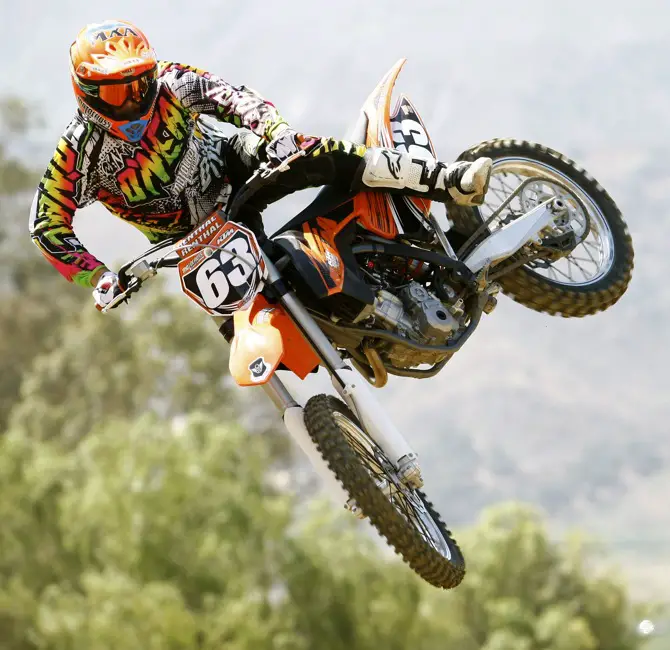
MXA KTM 250SXF SETUP SPECS
Are you looking to get the 2013 KTM 250SXF suspension set up? Use these specs as a basis and adjust accordingly.
WP FORK SETTINGS
The KTM 250SXF has been plagued by excessive fork oil height for years. And so it goes with the 2013 model. Lowering oil height is a must-do (unless you like holding onto a jackhammer). For hardcore racing we recommend this fork setup on the 2013 KTM 250SXF (stock specs are in parentheses):
Spring rate: 0.46 kg/mm
Oil height: 380cc (390cc)
Compression: 11 clicks out (12 clicks out)
Rebound: 10 clicks out (12 clicks out)
Fork leg height: 5mm up
Note: When the forks are new, they need about an hour of riding to break in. Lighter riders might want to lower the oil height by an additional 5cc to 10cc, depending on skill level. Decrease the oil height until the midstroke harshness is gone, but not so far that the forks bottom.
WP SHOCK SETTINGS
Although KTM completely overhauled the 250SXF engine, they did very little to the Dutch-build WP suspension. We’re have grounds to complain because the 250SXF shock has a tendency to hop and deflect on square-edge bumps. After toiling with a bunch of different settings, we discovered that over-adjusting the shock hampered handling, and vice versa. So we took the best of both worlds approach by slowing down the rebound and high-speed compression (and avoiding square-edges whenever possible). For hardcore racing we recommend this shock setup on the 2013 KTM 250SXF (stock specs are in parentheses):
Spring rate: 5.4 kg/mm
Race sag: 102mm
Hi-compression: 1-3/4 turns out (2 turns out)
Lo-compression: 15 clicks out (16 clicks out)
Rebound: 13 clicks out (15 clicks out)
Notes: KTM 250SXF shock spring rates have changed over the years. Back in the no-link era they ran a 6.9 kg/mm spring. With the introduction of linkage in 2011 they installed a 5.1 kg/mm spring, but in 2012 and 2013 they spec’ed a 5.4 kg/mm spring. The 5.4 is perfect or everyone but very light riders. Also, the shock is very sensitive to sag.





Comments are closed.